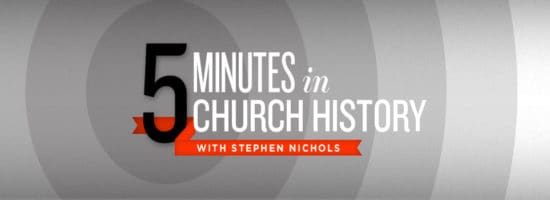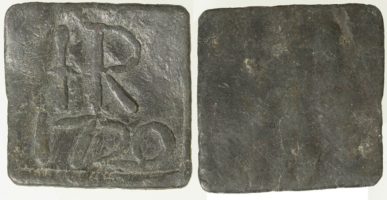
Bonnie Banks and Communion Tokens
What is a “communion token”? On this episode, Dr. Stephen Nichols explains why church members in Scotland had to present these little metal coins to take the Lord’s Supper.
 I’m holding in my hand an artifact from church history. It measures about three-quarters of an inch across the top and about one inch down the sides. This little rectangle is made of tin or lead, and it has the initials “J.R.” stamped onto it, and underneath, a date—1720. What is this artifact from church history?
I’m holding in my hand an artifact from church history. It measures about three-quarters of an inch across the top and about one inch down the sides. This little rectangle is made of tin or lead, and it has the initials “J.R.” stamped onto it, and underneath, a date—1720. What is this artifact from church history?
It’s a communion token. The initials “J.R.” stand for James Robertson. He was the pastor of a church in Balquhidder in Loch Lomond, Scotland. The year 1720 was very important. You might have heard of the legends of Rob Roy MacGregor of Scotland. It was during this precise time from the 1710s through the 1720s that Rob Roy was engaged in the exploits that would become part of his legend. He would die in 1734 and would be buried in the churchyard at Balquhidder in Scotland. If you draw a straight line across from St. Andrews way over to the west of Scotland, you would come to this little town that is now in the middle of what is today Loch Lomond National Park. This may bring to mind the song “The Bonnie Banks o’ Loch Lomond” and the line “O ye’ll tak’ the high road, and I’ll tak’ the low road.”
Beyond the geography of James Robertson’s church, we need to talk more about this communion token. The roots of communion tokens actually go back to John Calvin. It was his desire that the members of his church would be given these tokens. He wanted to have a company of pastors at the church of Geneva meet with members of the church throughout the week, and the pastors would give tokens to those whose souls were ready to participate in the Lord’s Supper. When the Lord’s Day rolled around and it was time for the Lord’s Supper, parishioners would present their tokens and would be allowed to partake at the Lord’s Table.
Calvin was not able to implement this practice, but some of the French Huguenots who were influenced by Calvin’s Geneva were able to implement it. The practice especially took hold in Scotland. It was brought there by John Knox. These communion tokens were all over Scotland, and even down into England, through the late 1600s and into the 1800s. And so, we have this one with Pastor James Robertson’s initials from 1720.
The idea of the Holy Fair, sometimes called the Scottish communion season, was developed in Scotland, as well. The Holy Fair was a designated week out of the year when Christians from different churches across Scotland would to come to a particular location to celebrate the Lord’s Supper. There would be a week of messages. The first messages would be about what great sinners we are, and the messages that followed would be about how Christ is an even greater Savior. This would all culminate in the celebration of the Lord’s Supper. How would those who administered the Lord’s Supper know that the people coming to the table were indeed coming in a worthy manner? Their pastors would have given them communion tokens.
In fact, when Scottish and Scots-Irish Presbyterians settled in the Carolinas, they brought these Holy Fairs and communion seasons with them. To this day, we have these little pieces of tin that remind us of this important practice from church history.
Stay connected with 5 Minutes in Church History by getting the weekly podcast on iTunes, SoundCloud, or via RSS. You can also subscribe to the blog via RSS and follow us on Twitter and Facebook.
(This podcast is by Ligonier Ministries. Discovered by Christian Podcast Central and our community — copyright is owned by the publisher, not Christian Podcast Central, and audio is streamed directly from their servers.)